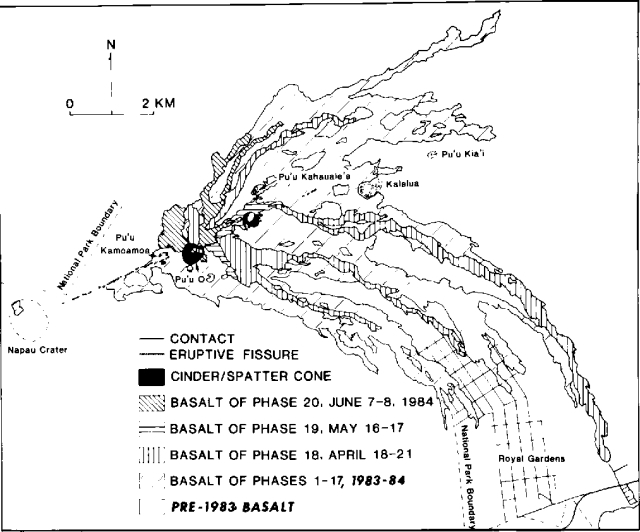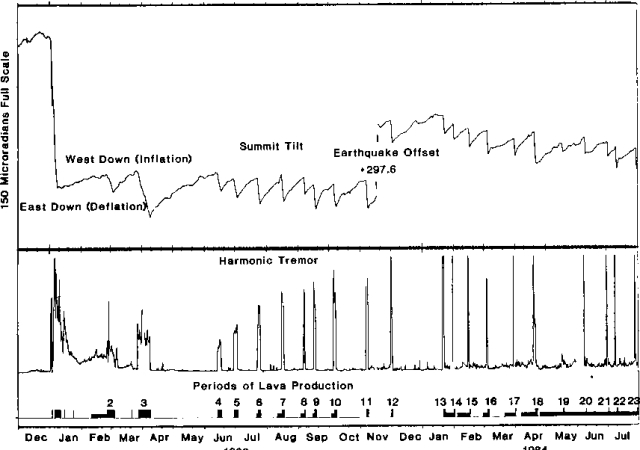Report on Kilauea (United States) — May 1984
Scientific Event Alert Network Bulletin, vol. 9, no. 5 (May 1984)
Managing Editor: Lindsay McClelland.
Kilauea (United States) 19th and 20th episodes; gas-piston activity
Please cite this report as:
Global Volcanism Program, 1984. Report on Kilauea (United States) (McClelland, L., ed.). Scientific Event Alert Network Bulletin, 9:5. Smithsonian Institution. https://doi.org/10.5479/si.GVP.SEAN198405-332010
Kilauea
United States
19.421°N, 155.287°W; summit elev. 1222 m
All times are local (unless otherwise noted)
"A small, relatively low-level eruption at Pu'u O on 16-17 May comprised an effusive episode in the eruption that began on 3 January 1983. Unlike the preceding eruptive episodes, which have been characterized by generally steady, voluminous lava emission and continuous vigorous fountaining, episode 19 was characterized by intermittent low-volume overflows from a lava pond in the crater of Pu'u O and a few brief periods of increased lava emission and high fountaining.
"After episode 18, and continuing through late April and the first half of May, the top of a magma column, partly crusted much of the time, remained tens of meters deep in the 20-m-diameter pipe that descends from the floor of the Pu'u O crater. At times, low-level spattering could be seen within the pipe from passing aircraft.
Episode 19
Eruption narrative. An observer on the ground in the eruption area saw intermittent spatter at Pu'u O beginning shortly after 0200 on 16 May. At about 0500, the first of many small pahoehoe flows of episode 19 (figure 26) spilled through the deep breach in the NE part of the crater rim. The flows typically lasted about 3-30 minutes and carried lava at about 103-105 m3/hour. Intervals ranging from 4 minutes to several hours separated these small effusive events.
 |
Figure 26. Lava flows erupted from Kīlauea between 3 January 1983 and 8 June 1984 on the E rift zone. Flows from phases 18-20 are shown separately. Courtesy of HVO. |
"During episode 19 an active lava lake was maintained within Pu'u O. At times the lake was confined to the upper part of the pipe; at other times it rose and spread across the crater floor. Flows issued quietly from the crater whenever the pond rose high enough to overflow the breach. A dome fountain played intermittently on the pond surface above the pipe, particularly during times of more rapid lava supply.
"In addition to the numerous, relatively quiet overflows of the pond, there were 4 periods, 1-3 hours long, of high fountaining with more vigorous lava production estimated at 1-2 x 105 m3/hour. A fountain 30-100 m high played on the pond surface during these episodes on 16 May at about 0940-1226, 1510-1608, 1840-2020, and 2355-0125 on 17 May. The first high fountain event was marked by rapid 2- to 3-fold changes, about a minute apart, in fountain height. These were followed within seconds by similar changes in lava discharge through the breach. In addition, this nearly 3-hour episode stopped and restarted 14 times. The pauses ranged in duration from a few seconds to 4 minutes. Vigorous lava emission and high fountaining would stop and start almost instantaneously at those times.
"During the evening of 17 May, the overflows from Pu'u O were smaller and more uniform in duration and spacing than previously. Several observations suggested that regular gas-piston activity had become established. During 3 hours of careful timing, the overflows averaged about 5 minutes in duration and occurred in cycles with an average length of 12 minutes. In each a [brief gas] burst was recognized immediately before the overflow stopped. Vigorous drainback into the pipe at the termination of overflow was seen within the crater in the late afternoon; presumably such drainback events, initiated by gas bursts, terminated each of the evening overflows. In addition, the distinctive bursts of tremor that we have come to associate with the drainback episode of gas-piston events were occurring with the same regularity as the overflows. At about 0030 on 18 May, the tremor bursts diminished in amplitude and became exceedingly regular, suggesting that the overflows probably stopped at that time.
"The repeated overflows from the crater built a relatively smooth apron of dense pahoehoe within a kilometer of the E base of Pu'u O. The higher lava emission associated with the periods of strong fountaining produced narrow, thin flows of pahoehoe and some aa that extended 2-3 km E and SE of the vent. Total estimated volume of new basalt is about 106 m3.
"The lithology and lava temperature resembled those of previous episodes. The basalt is nearly aphyric with scattered small olivine phenocrysts. Temperatures measured by thermocouple in overflows were 1,138-1,141°C.
"Measurements of SO2 flux during episode 19 gave surprising results. Even during the periods of high fountaining, it was comparable to that measured during repose periods when the magma column was visible within the pipe. That value was about two orders of magnitude less than the SO2 flux measured during previous eruptive episodes.
Seismicity and deformation. "After episode 18, harmonic tremor centered at Pu'u O remained low and continuous. Intermittent high tremor was associated with renewed fountaining during episode 19. On 16 May at 0640, background tremor began to increase rapidly, initiating a series of alternating [periods of] high- and low-amplitude tremor episodes at intervals of several minutes to several hours. Periods of relatively high and sustained tremor (0940-1255, 1423-1625, and 1857-2025 on 16 May; and 2351-0135 on 16-17 May) coincided closely with the intermittent high-fountain events seen at Pu'u O. After the high-fountain events, tremor of intermediate amplitude continued at irregular intervals, coincident with overflows at Pu'u O, until 1600 on 17 May.
"Tremor amplitude shown in figure 27 is misleadingly low. Amplitudes during the high-fountain events were comparable to those of previous episodes. However, the events were intermittent and of short duration, and they occurred between the programmed sampling intervals on which the tremor-amplitude plot was based.
"The Uwekahuna E-W tiltmeter, above the NW flank of Kīlauea's summit reservoir, showed that slow deflation of the summit began at about 1100 on 15 May, 18 hours before the first lava overflowed from the crater. Following a gradual 1.5-µrad deflationary tilt change, the rate of summit deflation increased, after high fountain activity had begun. By 0600 on 17 May, when deflation stopped, an additional 4 µrad of deflationary tilt change had been recorded. Gradual reinflation began at about 1100 on May 17, half a day before the overflows at the vent stopped.
Post-Episode 19 activity. "From 17 May until the end of the month, the tremor pattern was dominated by cyclic low-level tremor. Half-minute bursts of higher amplitude alternated with 8-12-minute intervals at lower amplitude. Repeated observation at the vent showed that the short bursts of higher tremor occurred during the gas burst and the accompanying vigorous drainback in gas-piston events.
"The pattern of periodic half-minute tremor bursts was temporarily interrupted by more continuous intermediate-level tremor from 1020 on 28 May to 2330 on 30 May. Observation at the vent on 29 and 30 May showed that the top of the magma column was open and smoothly boiling at the top of the pipe. Slowly rising and falling over a 2-m range, it occasionally spilled a minor flow onto the flat crater floor. There was no gas-piston activity.
"By 31 May, the top of the magma column was several meters down the pipe, and gas-pistoning had been re-established. Occasionally, the rise of the gas volume through the magma column caused a small pahoehoe flow to well out of the pipe and spread over the nearby part of the nearly flat 100 m-diameter crater floor. When the gas accumulation broke through the magma column surface, a flare of burning hydrogen could be seen during the drainback.
"Just under 2 µrad of deflation were associated with the period of increased harmonic tremor on 28-30 May. As in episode 19, the onset and termination of deflation preceded by several hours the onset and termination of increased tremor."
Addendum: Episode 20 began at approximately 2115 on 7 June and ended at about 0625 on 8 June. Very vigorous lava fountains, visible for a short time from HVO, fed 2 lava flows that extended about 4 km NE of Pu'u O.
Geological Summary. Kilauea overlaps the E flank of the massive Mauna Loa shield volcano in the island of Hawaii. Eruptions are prominent in Polynesian legends; written documentation since 1820 records frequent summit and flank lava flow eruptions interspersed with periods of long-term lava lake activity at Halemaumau crater in the summit caldera until 1924. The 3 x 5 km caldera was formed in several stages about 1,500 years ago and during the 18th century; eruptions have also originated from the lengthy East and Southwest rift zones, which extend to the ocean in both directions. About 90% of the surface of the basaltic shield volcano is formed of lava flows less than about 1,100 years old; 70% of the surface is younger than 600 years. The long-term eruption from the East rift zone between 1983 and 2018 produced lava flows covering more than 100 km2, destroyed hundreds of houses, and added new coastline.
Information Contacts: E. Wolfe, A. Okamura, and R. Koyanagi, HVO.


